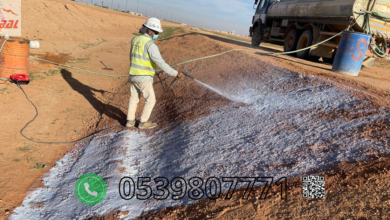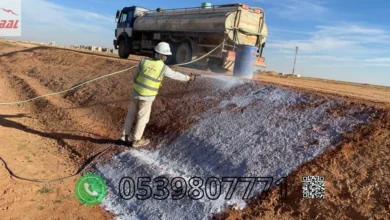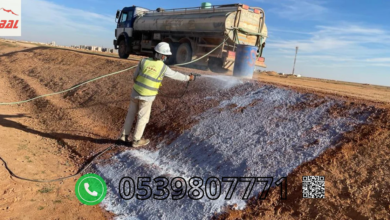Advantages and Disadvantages of Different Soil Stabilization Methods
مزايا وعيوب طرق تثبيت التربة المختلفة لشركة جبل للمقاولات

Advantages and Disadvantages of Different Soil Stabilization Methods by Jabal Contracting
Soil stabilization is a fundamental aspect of constructing and maintaining infrastructure, and it is a key part of our projects at Jabal Contracting. In this article, we review the advantages and disadvantages of 11 soil stabilization methods we offer, including the use of modern materials and diverse techniques:
- Aggregate
- Geotextiles
- Compaction
- Over-excavation
- Cement
- Lime
- Polymers
- Chlorides
- Asphalt
- Vegetation
But first, let’s define what soil stabilization is.
What is Soil Stabilization?
Soil stabilization is the process of altering the physical, chemical, or biological properties of soil to meet engineering needs, such as strengthening soil or reducing its permeability to water. Soil stabilization is used in many projects, including:
- Roads
- Mining
- Solar farms
- Erosion control
- Pond lining
Types of Soil Stabilizers
Soil stabilizers are generally divided into three main categories: physical, biological, and chemical. Each type improves the soil’s load-bearing capacity and durability but in different ways. Let’s look at these methods.
Physical Soil Stabilization
Physical stabilization uses certain materials and tools to improve the soil. Examples include aggregates and geotextiles, while mechanical techniques include dynamic compaction, vibratory compaction, and over-excavation.
Aggregate
Aggregate consists of processed rocks of specific sizes. It is a natural soil stabilizer used in various applications. For instance, coarse aggregate is used in areas with heavy traffic, such as project entrances and over-excavated zones.
Advantages and Disadvantages of Aggregate
Aggregate is widely used in road projects, making it familiar to engineers and contractors. However, importing and transporting aggregate can be expensive. Using the wrong size can reduce effectiveness—for example, fine aggregate may make surfaces slippery when wet. Aggregate also generates dust and may need replacement over time due to weather and water exposure.
Geotextiles
Geotextiles are woven fabrics used to stabilize soil and rocks. They can be applied in roads, sea barriers, and other infrastructure projects.
Advantages and Disadvantages of Geotextiles
Geotextiles are cost-effective and easy to install, with excellent water drainage properties. However, they can be damaged or clogged by sediments and fungi, reducing efficiency and sometimes requiring replacement.
Chemical Soil Stabilization
Chemical stabilization involves using industrial materials such as cement, lime, polymers, and chlorides to strengthen soil.
Cement
Cement is mixed with soil and water to bind soil particles together, creating a stronger surface. This method is common in paved roads.
Advantages and Disadvantages of Cement
Cement is strong and water-resistant but brittle and prone to cracking. It requires specific moisture and temperature conditions and precise mixing. Cement is also relatively expensive.
Lime
Lime is a mineral used to stabilize expansive soils like clay, reducing swelling and shrinkage caused by moisture changes.
Advantages and Disadvantages of Lime
Lime strengthens soil and reduces the need for over-excavation, with some environmental benefits. However, incorrect application can lead to ineffective results, and lime may irritate the skin and eyes.
Polymers
Polymers are long-chain molecules used to bind soil particles, enhancing soil load-bearing capacity. They are less effective in fine soils such as clay.
Advantages and Disadvantages of Polymers
Polymers are widely available and work well with coarse soils, but they may degrade over time due to moisture and require replacement.
Chlorides
Chlorides, such as magnesium chloride and calcium chloride, reduce dust and improve soil stability by absorbing moisture from the air and reducing evaporation.
Advantages and Disadvantages of Chlorides
Chlorides are highly effective in reducing dust and improving visibility and can also prevent freezing in cold areas. However, after rainfall, treated roads may require re-application to maintain dust control effectiveness.
Biological and Enzymatic Stabilization
Biological stabilization uses plants to strengthen soil, with roots helping control erosion. Chemical/enzymatic stabilization uses enzymes that react with soil to enhance stability.
Vegetation
Plants stabilize soil and reduce erosion, providing a cost-effective and environmentally friendly option in some projects.
Advantages and Disadvantages of Vegetation
Plants are a natural and economical solution but may be less strong than artificial methods and may not suit all soil types or locations.
Conclusion
Soil stabilization is essential to improving soil strength and ensuring the stability of construction projects. Jabal Contracting offers a wide range of specialized solutions, from natural materials like aggregates to advanced chemical stabilizers. Our experienced team is ready to provide consultation and implement optimal solutions tailored to the specific engineering needs of each project.





